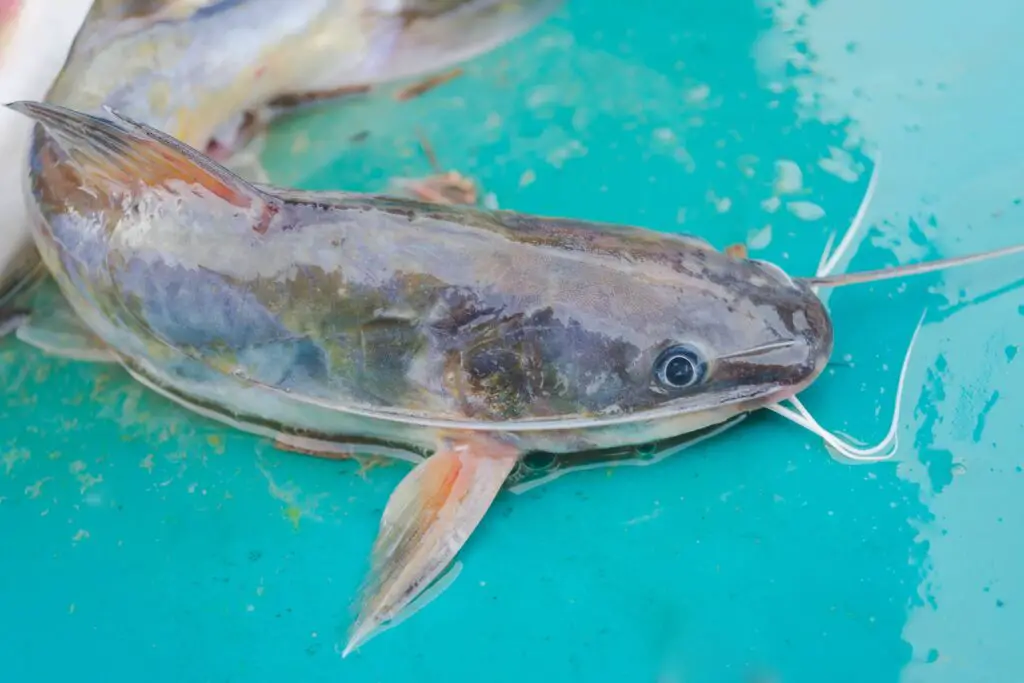Catfish and dogfish have unique shapes and colors that set them apart from other fish. Catfish are often called “wet livers” because they excrete a wet secretion called mucus to ward off predators. Dogfish have a thick, oily layer on their skin, making them resistant to parasites and predators. The two fish mentioned in this article are different in features and characteristics. Dogfish live in saltwater, unlike most catfish. Dogfish are smaller sharks. The catfish moves faster and eats more aggressively than the dogfish.
Catfish Vs. Dogfish- What’s the Difference?
There are long whiskers on catfish. Catfish live in lakes, ponds, rivers, and the ocean. This fish is recognized by its whiskers and fat. Its mouth and whiskers resemble cats. The spines on a catfish’s dorsal and pectoral fins defend against predators. It has two barbels, one of which is more pronounced, and a big head.
Catfish inhabit murky rivers and lakes. However, the dogfish prefers salty water like the Mediterranean Sea. Catfish may not do well in salt water, and they may not struggle for food with dogfish. Catfish are named for their vast barbells. Dogfish have long mouths and enormous eyes, but no barbels.
Catfish devour aquatic vegetation and smaller fish and mammals. Dogfish are meat-eaters. They feed like giant sharks and devour smaller aquatic animals. Catfish don’t have teeth, yet their broad mouth enables them to consume quickly and swallow whole. Dogfish can quickly seize and crush prey with their small, strong teeth.
Dogfish can grow big, too. Catfish weigh 4–300 pounds, depending on the species. For example, Wels catfish can weigh 300 pounds or more, while channel catfish weigh up to 30 pounds. The average dogfish weighs around eight pounds. However, their weight depends on what they consume and where they dwell.
Catfish are poisonous. Dogfish are dangerous and aggressive. They keep looking for food. Catfish must be swift and stealthy to grab and eat prey. Dogfish are eaten by seals, sharks, and predatory birds.
Catfish sell well and are easy to catch. You’ll need a big boat and plenty of live bait to catch dogfish in the ocean. River anglers may do this easily with catfish. Regular circle hook rigs catch catfish. Most dogfish fishermen use claw hooks. The claw hook holds the dogfish when captured well when they are hooked. Catfish are easier to catch when caught but they fight hard.

Catfish Vs. Dogfish- Quick Facts
-
- Dogfish sharks have 119 species. Dog sharks and spiny dogfish are also dogfish.
-
- Catfish have more than 3000 species.
-
- Catfish and dogfish are both friendly fish.
-
- Dogfish life expectancy is much higher than catfish.
-
- Catfish make a better pet.
-
- Dogfish have narrow bodies and keen mouths. They lack anal fins but have two smooth dorsal spines. Don’t touch their tough skin. These sharks are also smaller.
-
- They eat meat, especially smaller animals. They eat capelin, mackerel, and herring.
-
- Dogfish are tiny sharks. Most dogfish live in saltwater and most catfish in freshwater. Catfish are faster than dogfish because they eat fiercely.

Catfish & Dogfish Habitat
Catfish live in a lot of different places. They live in many other areas, some of which don’t seem very friendly. There are different kinds of catfish on every continent except Antarctica. The most variety is in tropical Africa, South America, and Asia, but one family is from America, and another is from Europe. They can be found in coastal or inland waters. The Americas are home to most of the world’s catfish species. They are the only Ostariophysi that have moved into freshwater ecosystems in Australia, New Guinea, and Madagascar. They live in lakes, streams, rivers, ponds, marshes, and more. Most live in different places, but some are only found in certain ecosystems or regions.
Most dogfish live in shallow water near the coast. Instead of swimming in the open sea, they hunt for food on the seafloor. They have been found up to 3,000 feet below the surface by experts. Unlike most other types of sharks, these will swim in subarctic waters. They can be found all over the world in temperate and subarctic places. They can be found almost anywhere except at the poles and the equator. You can find these sharks along the coasts of southern Africa, South America, and Australia. Their range also includes the whole eastern coast of North America and the southern part of Greenland. You can also find them on the shores of Europe.
Dogfish Vs. Catfish Physiology
-
- Catfish are scaleless. An adipose fin, fleshy, rayless back fin, and spines on the pectoral and dorsal fins are typical. Several catfish have two dorsal fin spines.
-
- Bony plates or no plates cover its body. Barbels are frequently found in pairs on the nose, the tip of the lips, and the chin. Nose and chin barbels may be absent.
-
- The dogfish is long and narrow with a flat head, long, narrow, and pointed, the nose. Dogfish eyes are average size.
-
- The first dorsal fin is midway between the pelvic and pectoral fins. It is located behind the pectoral fins. The second dorsal fin is roughly 2/3 of the first behind the pelvic fins.
-
- Gray-brown spiny dogfish backs. Small white patches go from the pectoral fins to the pelvic fins on either side. Young fish have these markings, and some dogfish lose them entirely as they age.
Catfish and Dogfish Reproduction
Much like other animals, fish must reach sexual maturity before reproducing. To lay eggs, catfish require a specific temperature. To spawn is to deposit eggs. Catfish reside beneath rocks, vegetation, or wood, because this area is avoided by predators. The female catfish lays her eggs in the nest. It can lay a few to 21,000 eggs. White and channel catfish store their eggs until they hatch. In 10 days, the catfish eggs hatch. The sperm of male catfish fertilizes them. The man keeps an eye on the baby catfish for a week. After one week, the fry can leave the nest.
Dogfish fertilize their eggs on land but mate in the water. After then, sharks go through ovoviviparous development. Around 4-6 months pass before the feeding membrane of the embryo degrades. The mother is shielded by the head-first babies’ cartilaginous spine sheaths. The baby will consume the yolk sac for 17 to 19 months. This fish has the longest gestation period of any vertebrate at 24 months.
Consumption of Catfish and Dogfish
Europe, North America, Africa, and Asia have caught and eaten catfish for centuries. Some think catfish is bland and watery, while others love it. Catfish contain vitamin D. Farm-raised catfish have more omega-6s than omega-3s. Channel and blue catfish are the most popular US catfish. Europeans, Venezuelans, Chileans, New Zealanders, Americans, and Canadians eat dogfish. Italy, France, England, Germany, and the Benelux countries consume most shark meat. Fin needles are made from tails and fins for cheap shark fin soup.
Fish and chip businesses call dogfish “huss” in England. “Rock salmon” was called “huss” before it was prohibited. “Sea eels” in Germany and Belgium, “little salmon” in France. Dogfish bodies make pet food, liver oil, and fertilizer. These countries enjoy dogfish because it tastes nice, feels good, and can be utilized to make many various dishes—kebabs, soup, Venezuelan “empanada,” etc. Oily fish meat is also popular because it smokes well. Dogfish is much sweeter and milder in taste than catfish. It is considered one of the tastiest seafood.
Catfish vs. Dogfish Nutrition Fact
Catfish and dogfish are both fish, but they differ in their nutritional content. Catfish are a type of whitefish that tend to be higher in protein and lower in fat than dogfish. On the other hand, dogfish are a type of shark that typically have a higher fat content. In terms of calories, however, there is no significant difference between the two types of fish. In terms of calories, Catfish have about 60 percent fewer than dogfish. Regarding vitamins and minerals, catfish boast more than twice the amount of vitamin D as dogfish. But catfish is lower in sodium and iodine than dogfish.











